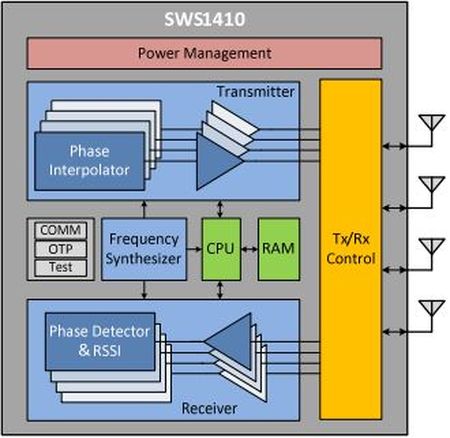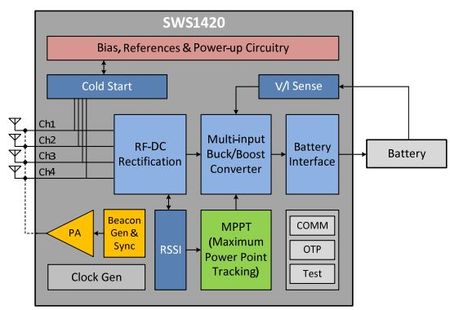By MICHAEL NAGIB
Technical Marketing Leader
ASIC Solutions Business Unit
Si-Ware Systems
www.si-ware.com
The wireless charging market will see exponential growth over the next several years. The growing panoply of mobile devices in the home, increased interest in wearables, and the gradual evolution of the truly smart home and the Internet of Things (IoT) foreshadow a huge surge in the number of battery-powered devices in the home and office. These devices will require recharging without resorting to a daily routine of plugging in, battery swaps, or a rat’s nest of cables in every room.
Wireless charging: Moving beyond induction
Much of the induction-based charging technology we see today has severe limitations in range and freedom of motion. The current standard, induction-based charging, requires either contact or very close proximity (within centimeters) to a mat or transmitter. The drawbacks are evident: You must place your devices on a mat and leave them there to charge.
The charging challenge
A fully integrated chipset for a new, RF-based wireless charging approach, called Cota, is developed by Si-Ware and Ossia to efficiently power devices wherever they are, even roaming in a building, without the constraints of induction or other forms of line-of-sight charging techniques. Ossia’s main requirements for the design included having a commercially viable first-generation chipset that would not only demonstrate the charging technology but also demonstrate the viability of the technology in everyday use. The main functionality of the system is to deliver power to multiple client devices in a dynamically changing environment at a radius of up to 10 m. The system needed to overcome line-of-sight dependency yet avoid obstructions, all while charging small devices, even in a hand or purse. Receiver chips had to be small enough to be integrated into almost any device, from a smartphone to an AA battery. More importantly, the transmitter/receiver chipset had to be cost-effective and manufactured using standard CMOS technologies for deployment in cost-sensitive consumer applications.

Wireless charging must deliver power to multiple devices in a changing environment at up to a 10-m radius.
Using smart antennas for a massive multipath approach
The Cota solution is a multipath technology, relying on smart micro-antennas to find multiple optimal paths for delivering RF power from the charger to the client receiver. Rather than inefficiently blasting out power in hopes of hitting the target devices, multipath technology relies on dynamic location tracking and precise RF signals sent directly to the receiver, avoiding obstructions in the environment.
Si-Ware’s chipset solution is based on Ossia’s Cota wireless charging concept. Detailed analyses and system-level simulations of overall system operation at frequent intervals led to the development of a transmitter (See Fig. 1: SWS1410) and receiver (See Fig. 2: SWS1420) chipset that supports up to eight simultaneous clients and is produced in standard CMOS technology. An evaluation kit for the Cota technology based on the SWS1410 and SWS1420 will be available in the second half of 2016.
 Fig. 1: The SWS1410 MIMO transceiver detects the location of multiple devices simultaneously and transmits RF power to those devices through a multipath approach.
Fig. 1: The SWS1410 MIMO transceiver detects the location of multiple devices simultaneously and transmits RF power to those devices through a multipath approach.

Fig. 2: The SWS1420 receiver rectifies and converts RF power into DC power to charge batteries and transmit a beacon signal to assist in client dynamic location tracking.
Obstacle avoidance and safety
The implementation of the massive multipath technique answered the requirements for obstacle avoidance and human safety but necessitated work on integration and silicon dimensions to satisfy volume production needs. On the safety side, both chipsets have a variety of special features and error-detection mechanisms to detect and prevent any unexpected behavior in the system in any mode of operation. Both charger and receiver include signal-strength indicators, temperature sensors, and safe power-up infrastructure to monitor and ensure safe operation of the whole system under different operating conditions.
Power management
Implemented at different levels across the Cota wireless power delivery system, power management begins with optimizing power delivery per client on the system level, proceeding down to efficient extraction of RF power on the client side, and then interfacing to the battery in the most economical way.
The SWS1410 charger ASIC has built-in power management features and flexibility that enable dynamic system-level optimization of the power delivered to different devices, enabling the charger to prioritize charging based on the nature of the device, and battery state-of-charge.
On the client side, the SWS1420 has an embedded dynamic MPPT (maximum power point tracking) loop that dynamically enhances the RF-to-DC rectification efficiency. It also has a buck/boost converter that acts as a host-controlled battery interface supporting Li-ion battery charging profiles. This enables the client ASIC to directly charge the system battery, reducing the number of additional power-management elements and the associated extra power consumption and inefficiencies.
Streamlining chip architecture
The SWS1410 transmitter chip includes its own CPU and RAM to offload the location data calculations and storage overhead from the main system controller. These features enable the SWS1410 ASIC to operate in a completely autonomous mode and significantly reduces the overall cost and complexity of the complete Cota charger. The SWS1420 client ASIC integrates a complete host-controlled battery interface that is compatible with popular Li-ion batteries, to reduce overall integration cost and complexity in the product migration path. Additionally, both chips support a wide range of applications and devices.
One key objective was the ability to enable OEM partners — from wearables to smartphone accessory and battery manufacturers — to easily integrate a small Cota receiver chip into their products. To address size and reduce the bill of materials (BoM) on the Cota charger side, the SWS1410 integrates four antenna management units with the location detection and tracking infrastructure — including the functionality of more than 10 RF and digital chips — into a single ASIC. On the client side, a complete power-management solution with MPPT loop and battery interface in the receiver IC is included — also to reduce the BOM — for OEMs integrating chips into their own devices.
Advertisement





